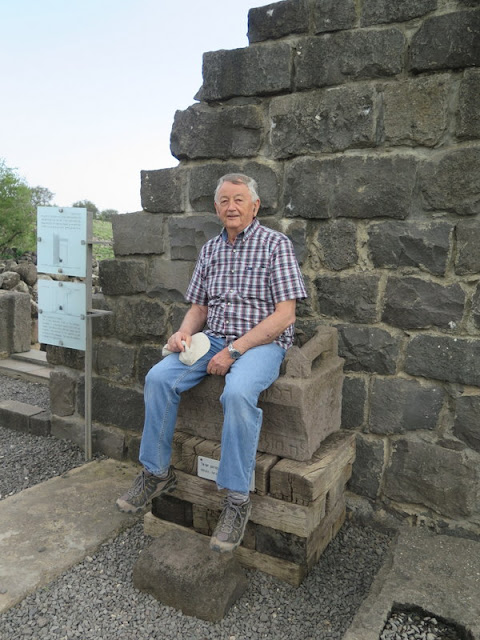Chorazin is noted as being one of the cities that Jesus cursed. The city is mentioned twice in the New Testament (Matthew 11:21;Luke 10:13) and both instances mention the curse that Jesus placed upon it.
Chorazim is 230 feet above sea level and in a region strewn with basalt rocks.
The Chorazin block was formed when there was a volcanic eruption and the flow of lava blocked the passage between the upper Jordan Valley and the Sea of Galilee. Once it solidified, the basalt caused a “plug” which prevented the river from flowing southward and therefore formed the Hula Lake and a narrow gorge as shown in the diagram below.

Photo: The hyrax were pretty big and I would estimate about 12" in length. They reminded us of large guinea pigs and possibly the inhabitants used them for food.
These are remains of the city’s commercial area.
Photo: Olive press.
The entrance faced Jerusalem. It’s face was lavishly decorated, including a richly adorned gable, the reconstruction of which now stand near the entrance.
Worshippers entered via three doorways . . .a high, wide central entrance and two smaller lateral ones.
The Bimah and the Torak Ark were set inside the hall on either side of the main entrance. These were ornamental closets in which the Torah scrolls were placed and covered by a curtain. Worshippers sat on benches placed alongside the walls and turned toward Jerusalem during prayer. The photo below shows a Torak Ark.
Archaelogical digs have yielded many treasures and the remains of this synagogue were made of black basalt stone. The synagogue measures about 50 feet by 70 feet in size.
We know from scripture that Jesus did many miracles in this city. These people witnessed the power of God in their streets for the better part of three years. Yet, it seemed to make no difference in their lives. Jesus finally said: “Woe to you, Korazin… If the miracles that were performed in you had been performed in Tyre and Sidon, they would have repented long ago in sackcloth and ashes. But I tell you, it will be more bearable for Tyre and Sidon on the day of judgment than for you.” (Matt. 11:21-22).
Photo: I stepped outside the synagogue and thought about Jesus, the inhabitants and the times he came here to preach. The town was small, the view was lovely and because there was no fortification around it, there was a feeling serenity. I was so glad to be there, to have a few minutes to meditate and to know this was a place Jesus came during the last weeks of his life. Even if one does not believe that Jesus was the Savior of the world, it is still an interesting place to visit because the inhabitants were real and the events that happened are an important part of history.
The archaeological excavations at Chorazin may also help us understand why the people received such a curse from God. Although it obviously happened some generations after Jesus, it is truly interesting that the descendants of these people would allow a Medusa to be built right into their synagogue wall. However, as early as the second century BC, the Medusa came directly from Greek mythology. Supposedly anyone who looked directly at Medusa (she had hair of snakes) was turned to stone and accordingly she was killed by Perseus who cut off her head.
































Thank you for your wonderful pictures. I've been to Israel 4X (1995-2016) but never been to Chorizan. It was great to see yours.
ReplyDeleteMark Jersin, mvjersin@yahoo.com